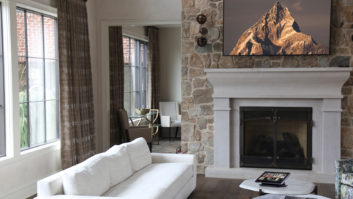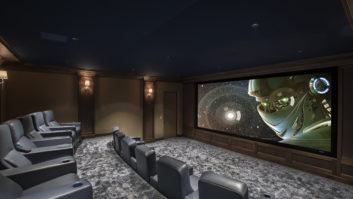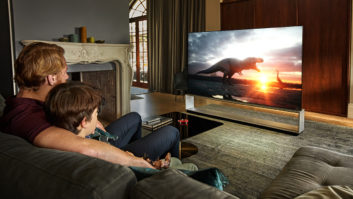I call it the disposable projector ploy. Two years ago, one of my employees bought a very nice 1280×720 video projector. Last year, he upgraded to a three-chip model. Just the other day, he told me that he was yet again looking to upgrade, this time to a substantial 1920×1080 machine. After thinking that I might be paying him too much, I began to cogitate on how difficult it is to specify video equipment in todays technology super-world.
Realistically, how can you as a responsible custom installer, possibly expect to find future-proof video equipment for your clients? You cant, so my suggestion is to focus as much as possible on the things that dont change.
THE SCREEN
Lets start by talking about how to pick the right screen. The first thing you have to consider is screen size. You might think this part is easy, but the correct screen size is not always the largest possible screen that will fit in the space provided. Determining the appropriate size is actually a complex endeavor that requires you to consider the resolution of the display device, the seating distance, the video codec format, the source material, and the human eyes visual acuity of 1/60 of a degree. All of that really boils down to is the following question: What do your clients watch?
Video is currently in a major transition from standard to high definition. This is true for TV, movies, and gaming. Even though HD DVD and Blu-ray are available, your clients arent going to be watching them all the time. What about five years from now? Perhaps by that time they will be watching mostly 1920×1080 material beautifully compressed with the latest codecs. Whether or not that happens, you cant afford not to plan for it, so the overall size of the screen frame and fabric should be based on viewing a high-quality 1920×1080 image. With that established, things start to fall into place. The widest subtended viewing angle that 1920×1080 will support without appearing to lose resolution is 40 degrees. That corresponds to a screen width (not diagonal) of 0.73 times the seating distance.
To illustrate, a 105-inch wide screen would be ideal for viewers 12 feet away. Now, realize that SD cable will look awful on a screen that big. I guarantee that you will receive calls from your clients claiming that their projectors suddenly broke when they turned on M.A.S.H. re-runs. Even DVD will look really soft, noisy, and full of artifacts. Your play here is to find a way to reduce the picture size (not the screen) and mask the unused screen area for low-resolution sources. Currently, there are two ways to accomplish this. The first is an anamorphic lens approach, also known as constant height. In a constant height system, the aspect ratio of the screen is 2.35:1, which corresponds to the widest theatrical aspect ratio in common use.
Video processing and an anamorphic lens are employed to display 2.35 movies on the whole screen using the full resolution of 1.78 imaging chips. Spherical 1.85 movies, 1.78 HDTV, and 1.33 SDTV are projected without the anamorphic lens at the same image height as 2.35, just not as wide. For true film buffs, nothing beats constant height because it works essentially the same way as a cinema.
For custom installation, Runcos CineWide/AutoScope system is probably the most ergonomic implementation of constant height, but a number of video processors and projectors also offer constant height modes. If you go the latter route, be careful; a specific type of anamorphic lens may be required.
The second option for shrinking the picture is to, well, actually shrink the picture. You do this by zooming the projector in and out, re-focusing and re-masking for each size. For sports buffs, gamers, and HDTV junkies, this is probably your best bet. If you were to go constant height, HD sports would end up being shown on the 2.35 screen as a smaller 1.78 image. Actually, it can be embarrassingly small. If you take the above example of a 12-foot viewing distance and a 105-inch wide screen and make it constant height, the viewable area would only be 80×45 inches for 1.78. Furthermore, some of the best high-definition material available is not even film-based, but rather video game computer graphics and direct digital photography. These are basically all 1.78; so having the second-smallest picture for potentially the sharpest, highest-quality material seems like a waste.
When you zoom the image, all of those concerns go out the window. The actual picture size increases and decreases based on resolution, source quality, and production values. A TV show or game is going to have too much close-up motion to view at a large size, so the picture is zoomed down and the screen masked to 20-25 degrees (0.35 x seating distance) to make it easier to watch. On the other hand, a big event like the Super Bowl is blown up to a nice, tall, 40-degree-wide image. Movies at 2.35 would also be zoomed up to 40 degrees.
The bottom line is that you should plan for 1920×1080 and a screen that subtends 40 degrees. Go constant height for a film buff and zoom for a sports or gaming fan.
After youve sized the screen, you have to choose the screen gain. With the advancements in digital projectors, a flat white screen is ideal for home theaters that have control over lighting and wall colors. Screens with a gray substrate or high gain are really for compromised situations with ambient light or bad projectors. You just dont need them for high-quality home theater applications. I talked about all of this in detail in the January 2006 issue.
You should also specify a screen with acoustical transparency. I talked about AT screens in January 2006 as well, so I wont repeat much here. Suffice it to say that the screen should be invisible to sound, and the center speaker should go behind it to avoid acoustic problems. And please, dont tell me the picture and sound quality will suffer. Some manufacturers now build AT screens that dont negatively impact either one in a noticeable way.
THE PROJECTOR
It may seem like picking the screen and then the projector is putting the cart before the horse, but its not. The screen is the starting point and constant because its the most likely to remain in service over time. Once you have the screen in place, its pretty easy to figure out what you need from the projector.
Light output is the first thing to research. The projector should be able to produce between 16 and 20 foot Lamberts (fL) off the screen. Because you already know the screen surface area and gain, you can figure out how many lumens the projector must output by using this calculation: Projector Lumens = Target foot Lamberts x Screen Area in ft2
Other things to look for in the projector are adjustable primary colors and grayscale. Along those lines, investigate ISF- and THX-approved products. I highly recommend that you research what it means for a product to meet their standards.
VIDEO PROCESSORS
A complete discussion of video processors would take way more space than I have, but here are the nuts and bolts. The final picture quality doesnt just depend on the video processor; its a combination of all the video devices in the signal path. Its impossible to predict which one will do the best job scaling, de-interlacing, etc. Youve got to find out for yourself by using test patterns. Get some test discs like Digital Video Essentials, AVIA, and HQV Benchmark, and go to town trying different combinations of settings. Avoid the urge to only use program material. You will miss some problems if you do.
THE SOURCES
For a long time satellite, cable, and broadcast were the only sources of HD, so we thought they were awesome. The new kids on the block, though, have blown those old standbys back into the last century. You need to have one of these new HD sources in your theaters, if for no other reason than to demonstrate the kind of picture the video system is capable of producing. HD DVD and Blu-ray obviously come to mind. Files on a video server are also a good idea.
Possibly the most intriguing new HD source comes from the gaming industry. HD cinematics in next-generation games are stunningly detailed, providing the perfect wow factor for a demo. In addition, the PlayStation 3 and Xbox 360 offer downloadable HD material that looks surprisingly good and only continues to improve. The Xbox 360 uses Wi-Fi in conjunction with Windows Media Player and Windows Media Center PCs to send HD video wirelessly throughout the home. If you want to impress your clients, be sure to show them something like this, and tell them to show the same thing to their friends. Dont just hand the system over to them and leave them to blunder through stacks of old DVDs, wondering where all their money was spent.
Chase Walton contributed to this article.







